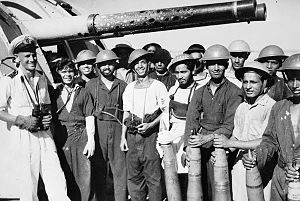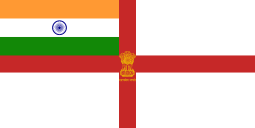HMIS Narbada
HMIS Narbada (U40) was a Modified Bittern class sloop, later known as the Black Swan class, which served in the Royal Indian Navy (RIN) during World War II.
 Crew of HMIS Narbada with blistered gun barrels following the bombardment of Myebon, Hunters Bay, Burma. | |
| History | |
|---|---|
| Name: | Narbada |
| Namesake: | Narmada River |
| Ordered: | 19 August 1940 |
| Builder: | Thornycroft |
| Yard number: | Yard 1385 |
| Laid down: | 30 August 1941 |
| Launched: | 21 November 1942 |
| Commissioned: | 29 April 1943 |
| Out of service: | 1948 |
| Honours and awards: | Burma, 1944-45 |
| Fate: | Transferred to Pakistan, subsequently scrapped (1959) |
| Badge: | On a Field Blue, rising from a base barry wavy of four, a trident gold, with a cobra proper entwined. |
| General characteristics | |
| Type: | Sloop-of-war |
| Displacement: |
|
| Length: | 299 ft 6 in (91.29 m) |
| Beam: |
|
| Draught: | 11 ft (3.4 m) |
| Propulsion: |
|
| Speed: |
|
| Range: | 7,500 nmi (13,900 km) at 12 kn (22 km/h) |
| Complement: |
|
| Armament: |
|
Narbada was transferred to Pakistan in 1948 after the Partition of India, and served as PNS Jhelum.
History
HMIS Narbada was ordered in 1940 as a part of the 1940 Build Program for the Royal Indian Navy. She was built by John I. Thornycroft & Company and commissioned in 1943.
With World War II underway, she was deployed as an escort to multiple Allied convoys en route to Bombay. Upon arrival, she joined the Eastern Fleet. In 1944, she was deployed for defence of military convoys in the Bay of Bengal.[2]
In early January 1945, she was deployed with HMIS Jumna to support the landing of the 74th Indian Brigade of the British Indian Army on Akyab Peninsular, as a part of Operation Lightning. Jumna and Narbada engaged Japanese batteries up the Kaladan River near Ponnagyun. After embarking troops, she joined Task Force 64 headed by HMS Phoebe for support of landing by 3rd British Commando Brigade between Akyab and Ramree with HMS Napier and HMIS Jumna.
On 13 January 1945, with the task force under attack by Japanese aircraft, Narbada downed an Oscar aircraft of the Imperial Japanese Army Air Force.
In February 1945, she supported the landing of the 53rd Indian Infantry Brigade at Ryuwa with HMS Flamingo and HMIS Jumna. She was hit aft by return fire, but continued operations.
In March 1945, she returned to Bombay for a refit and to repair damages.
In April 1945, she resumed escort duties and supported the Indian and British Army amphibious landings in Rangoon with HMIS Cauvery, HMIS Godavari, HMIS Kistna, HMIS Sutlej and HMIS Hindustan as a part of Operation Dracula.
In May 1945, she was deployed with HMIS Cauvery, HMIS Godavari, HMIS Kistna, HMIS Sutlej and HMIS Hindustan to intercept Japanese troops withdrawing from the Andamans.
In July 1945, Narbada was a part of the planned force for Operation Zipper and conducted preparatory exercises, before the postponement of the operation.
At the end of World War II, she was deployed during the Japanese surrender at the Andaman garrison at Port Blair by Vice Admiral Hara of the Imperial Japanese Navy.
After the Independence of India and the subsequent Partition, she was among the vessels transferred to Pakistan, where she was renamed HMPS Jhelum and subsequently, PNS Jhelum. She was scrapped in 1959.
Notes
References
- Hague, Arnold (1993). Sloops: A History of the 71 Sloops Built in Britain and Australia for the British, Australian and Indian Navies 1926–1946. Kendal, England: World Ship Society. ISBN 0-905617-67-3.
